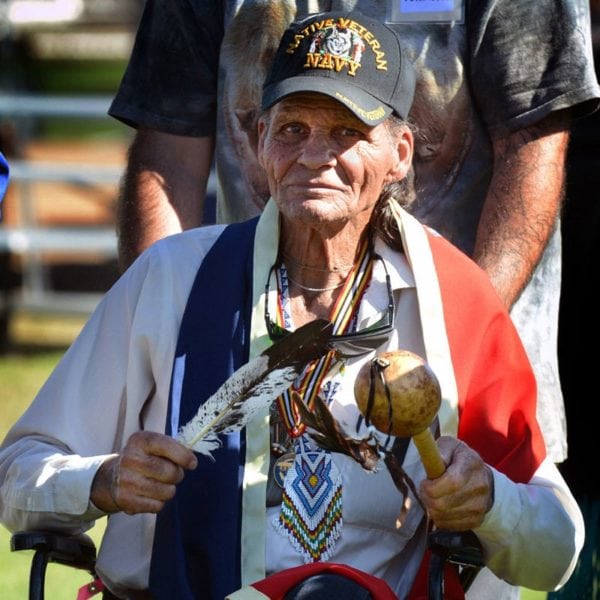
June 26, 2018; National Public Radio (NPR), “All Things Considered”
The Smithsonian’s National Museum of the American Indian has announced the winning concept for what will become the National Native American Veterans Memorial, reports Kat Chow for NPR. The idea behind the memorial is to honor the sizeable contributions of American Indians in the US military. The National Museum of American Indian notes that, “More than 12,000 American Indians served in World War I—about 25 percent of the male American Indian population at that time. During World War II, when the total American Indian population was less than 350,000, an estimated 44,000 Indian men and women served.” Since 9/11, American Indians have served in the US military at a rate that is higher than any other ethnic group.
In World War II, American Indians served as “code talkers” who played a crucial role in keeping military communications secret. The Navajo are best known for playing this role, but members of an estimated 30 American Indian nations were involved. The museum’s website adds that, “The Navajo and Hopi were assigned to service in the Pacific in the war against Japan. The Comanches fought the Germans in Europe, and the Meskwakis fought them in North Africa. Code Talkers from other tribes fought at various locations in Europe, the Pacific, North Africa, and elsewhere.”
The number of American Indian veterans has since increased. Chow notes that the 2010 census found more than 156,000 veterans identified as American Indian and Alaska Native. According to the US Department of Defense figures, today 31,000 American Indians and Alaskan Natives serve in the military and 140,000 living American Indian are veterans.
Congress authorized the creation of the memorial in 1994 to give “all Americans the opportunity to learn of the proud and courageous tradition of service of Native Americans in the Armed Forces of the United States.” Originally, the memorial was going to be inside the Museum of the American Indian. However, in 2013, Congress authorized placing a memorial on the grounds of the museum and authorized the museum to fundraise for the memorial.
Construction of the memorial is expected to begin on September 21, 2019, with the final memorial slated to be formally unveiled on Veterans’ Day (November 11th) in 2020. The design selected, Chow adds, is by multimedia artist Henry Pratt. Pratt’s work, Warriors’ Circle of Honor, “will incorporate a large, upright stainless-steel circle set above a stone drum in the center of a circular walkway with intricate carvings of the five military seals.”
The memorial will sit on the National Mall in Washington, DC, notes Chow, and “Pratt envisions a clear view of the US Capitol’s dome from there.”
Sign up for our free newsletters
Subscribe to NPQ's newsletters to have our top stories delivered directly to your inbox.
By signing up, you agree to our privacy policy and terms of use, and to receive messages from NPQ and our partners.
Pratt prevailed over four other finalists—namely, James Dinh, the team of Daniel SaSuWeh Jones and Enoch Kelly Haney, Stefanie Rocknak, and Leroy Transfield. All told, 120 designs were submitted. “The memorial was selected unanimously by an eight-person jury of Native and non-Native artists, designers, museum directors and veterans,” notes Chaw.
The eight jury members were:
- Larry Ulaaq Ahvakana (Inupiaq), artist, Ahvakana Fine Art
- Stephanie Birdwell (Cherokee), director, Veterans Affairs, Office of Tribal Government Relations
- Johnnetta Betsch Cole, director emerita, Smithsonian’ National Museum of African Art
- Edwin Fountain, general counsel, American Battle Monuments Commission
- Mark Kawika McKeague (Native Hawaiian), director of Cultural Planning, Group 70 International Inc.
- Brian McCormack (Nez Perce), Principal Landscape Architect, McCormack Landscape Architecture
- Lillian Pitt (Wasco/Yakima/Warm Springs), artist
- Herman Viola, curator emeritus, Smithsonian
Regarding Pratt’s design, the selection committee remarked:
This design is culturally resolute and spiritually engaging. The circle is so profoundly important in all Native cultures that the supreme strength of this design is its ability for all people to connect with it and find meaning in it. The design balances intimacy and openness. It shows the capacity and the spirit of Native People to address the complexity of values, cultures, and ancestral beliefs that have sustained us all for hundreds of years.
The museum’s director, Kevin Gover, who is a citizen of the Pawnee Tribe of Oklahoma, notes that American Indian veterans “are perfectly aware that they are serving a country that had not kept its commitments to Native people, and yet they chose—and are still choosing—to serve.”
Pratt say his goal with the memorial is for “it to be a place of healing and comfort, and a place that’s hopefully going to be built on love.”—Steve Dubb













